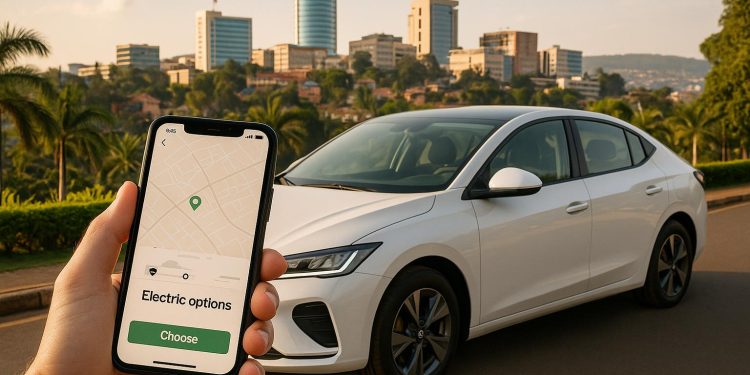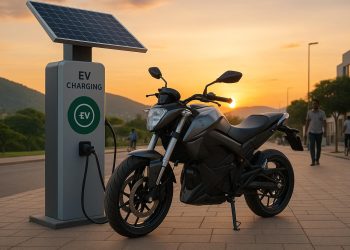Rwanda has implemented a new regulation requiring ride-hailing platforms to transition to electric vehicles (EVs). Effective January 1, 2025, only electric motorcycles can be registered, pushing platforms to shift their fleets. This initiative addresses air pollution, reduces fuel dependency, and aligns with Rwanda’s climate goals, including a 38% emissions reduction by 2030. Key points:
- Electric motorcycles dominate the transition: Companies like Ampersand and Spiro are scaling operations with battery-swapping networks.
- Economic benefits: Drivers save up to 45% on operational costs, and Rwanda could save $22 million annually on fuel imports.
- Government incentives: Tax exemptions, financing options, and charging infrastructure are supporting adoption.
This policy positions Rwanda as a leader in EV adoption, with benefits for the environment, public health, and the economy.
Rwanda turns to electric motorbikes to drive down emissions | AFP
Which Platforms and Vehicles Are Affected
The new mandate requires all ride-hailing platforms and commercial vehicle types in Rwanda to make the switch to electric options.
Platforms That Must Comply
Every ride-hailing platform in Rwanda is now obligated to include electric vehicles in their services. This applies to both motorcycle-based and car-based platforms operating in Kigali and other major cities. The regulation primarily affects platforms serving urban hubs like Kigali, where the government has prioritized the adoption of electric vehicles for commercial deliveries. For instance, Volkswagen Mobility Solutions Rwanda, which has served approximately 27,000 registered users and completed 59,500 rides since 2019, must now incorporate electric vehicles into its fleet. This shift is paving the way for new electric models to enter the ride-hailing market.
Vehicle Types Covered
The mandate outlines specific vehicle categories that must transition to electric power. These include electric motorcycles and buses, which are vital to Rwanda’s transportation system. Electric motorcycles, in particular, are the most impacted, as they dominate commercial taxi services in urban areas. Companies like Ampersand have already made significant strides, with over 5,700 electric motorcycles in operation and the milestone of their 1,000th electric motorcycle deployment in Rwanda reached by June 30, 2023. Spiro, another key player, operates more than 13,000 electric motorcycles and manages 40,000 swappable batteries across multiple countries, including Rwanda, Benin, Togo, and Kenya. On a larger scale, electric buses are also part of the transition. In June 2023, BasiGo teamed up with AC Mobility to launch BasiGo Rwanda Ltd., an initiative aimed at electrifying the public transport system in the country.
Why the Government Chose EVs
The decision to prioritize electric vehicles aligns with Rwanda’s broader goals to reduce fuel dependency and cut emissions. Prime Minister Dr. Ngirente Edouard highlighted that transitioning to e-mobility helps reduce costly fuel imports, which once accounted for 12% of the country’s total imports. This shift leverages Rwanda’s domestic electricity resources, making it a more sustainable and economical choice.
Environmental concerns are also a driving force. As Dr. Ngirente Edouard noted:
Rwandans are becoming increasingly aware that protecting the environment is a top priority. We are confident that the introduction of environmentally friendly transport services will accelerate the reduction of air pollution levels.
Adopting electric vehicles is a cornerstone of Rwanda’s strategy to build a low-carbon, climate-resilient economy, with a focus on smart green cities and sustainable transport. This commitment is reflected in the nation’s updated Nationally Determined Contribution (NDC), which emphasizes electric vehicles and emission standards as critical tools for reducing greenhouse gases. Beyond environmental and economic benefits, the government sees e-mobility as a way to create jobs, particularly for young people. Rwanda’s forward-thinking policies have even drawn international praise, with one source stating, "Rwanda has some of the most progressive policies in the world for electric vehicles". To support this transition, the government has introduced strong incentives for EV adoption across all vehicle types, ensuring a smoother path toward an electric future.
Electric Vehicles Entering Rwanda’s Ride-Hailing Market
Rwanda’s ride-hailing services are undergoing a transformation with the introduction of electric vehicles (EVs). From two-wheelers to four-wheelers, these EVs are reshaping the way people move around, bringing new models and features to the forefront of the country’s transportation sector.
EV Types and Models Available
Electric motorcycles are leading this transition. Ampersand has taken a prominent position, operating over 4,000 electric motorcycles as of May 2025. These bikes now account for 13% of Kigali’s motorcycle taxi market, with an impressive 14,700 daily battery swaps. Spiro is also making strides by rolling out thousands of electric motorcycles and establishing a broad battery-swapping network.
On the other hand, four-wheeled EVs are also entering the scene. Volkswagen has introduced 50 eGolf units as part of a pilot program to test their performance in urban settings.
Electric three-wheelers are carving out a niche as well. Although they have a shorter range and higher costs compared to traditional vehicles, they are finding their place in specific ride-hailing applications.
Features That Work for Ride-Hailing
These EVs aren’t just about being eco-friendly – they’re designed with features that enhance efficiency for ride-hailing. For instance, the Volkswagen eGolf can travel up to 143 miles on a full charge and can recharge 80% of its battery in just one hour, making it perfect for city trips. Drivers can also charge the eGolf overnight at home, with a full charge taking about 11 hours, which ensures minimal downtime.
For electric motorcycles, battery swapping is a game-changer. This system allows riders to quickly replace depleted batteries, keeping them on the road longer. Riders using these bikes also save 30–40% on operational costs compared to gasoline-powered alternatives.
Rwanda’s reliable charging infrastructure plays a crucial role in supporting these vehicles. With an installed power capacity of 286 MW, the country can handle charging demands, especially during off-peak nighttime hours.
EV Model Comparison
| Vehicle Type | Model | Range | Charging Time | Key Feature | Market Share |
|---|---|---|---|---|---|
| Electric Motorcycle | Ampersand | N/A | Battery swap (minutes) | Quick battery swapping | 13% of Kigali motorcycle taxis |
| Electric Motorcycle | Spiro | N/A | Battery swap (minutes) | Extensive swap network | Growing presence |
| Electric Car | Volkswagen eGolf | 143 miles (230 km) | 1 hour (80% fast charge) | Urban range capability | Testing phase (50 units) |
| Electric Three-Wheeler | Various models | Limited range | Standard charging | Specialized transport | Emerging segment |
This table showcases the strengths of each EV type. Electric motorcycles, with their rapid battery-swapping capabilities, are particularly well-suited for the demands of ride-hailing. Meanwhile, electric cars like the eGolf offer a more comfortable option for longer rides within urban areas. Three-wheelers, though still in the early stages, are proving useful for specific transport needs.
With its dependable infrastructure and welcoming business environment, Rwanda has created a fertile ground for testing and expanding EV technology. These developments are not only modernizing the ride-hailing market but also laying the foundation for continued advancements in electric mobility.
Economic and Environmental Impact
Rwanda’s mandate for ride-hailing platforms to include electric vehicles (EVs) is reshaping both the economy and the environment. These changes are improving air quality, boosting driver earnings, and driving the development of EV infrastructure, though they also bring challenges that need addressing.
Benefits for the Environment
By prioritizing electric vehicles, Rwanda is tackling a significant source of pollution: traditional fuel-powered vehicles. The impact is clear – EVs produce zero tailpipe emissions, leading to cleaner air in urban areas like Kigali.
"E-mobility is one of the transport decarbonization initiatives the government has undertaken." – François Zirikana, e-mobility specialist with the City of Kigali
Switching from fossil fuel-powered vehicles to electric ones cuts greenhouse gas emissions by half over the vehicle’s lifetime. EVs are also about 60% more energy-efficient compared to conventional vehicles. These efforts align with Rwanda’s ambitious climate goals, which include electrifying 20% of buses, 30% of motorcycles, and 8% of cars by 2030. This is part of a broader strategy to cut greenhouse gas emissions by 38% by the same year.
Financial Impact on Drivers and Passengers
The transition to electric vehicles is significantly boosting driver incomes. Electric motorcycle operators, for example, earn about 45% more than those using petrol-powered bikes, thanks to lower fuel and maintenance costs. This translates to annual savings of roughly $840 per driver. By cutting operational costs, drivers can work longer hours and increase their earnings.
On a national level, the shift to EVs is projected to save the Rwandan economy about $22 million annually in fuel imports. Between 2021 and 2025 alone, the country could save at least 20 billion RWF (around $15.6 million) in fuel costs. For passengers, the efficiency of electric vehicles helps offset their higher upfront costs. Lower energy expenses, combined with tax incentives and fuel savings, make EVs more affordable over time. For instance, the Union of Concerned Scientists estimates that a conventional light-duty car will consume around $22,674 in gasoline over 14 years, compared to just $12,132 for an EV – a 54% savings.
Challenges and Infrastructure Requirements
Despite these advantages, challenges remain. The high upfront cost of EVs is a significant hurdle for drivers and ride-hailing operators. Additionally, Rwanda’s current electricity capacity stands at just 225 MW, with only 53% of the population having access to electricity. To address this, the government has identified 224 strategic locations for charging stations across the country.
"The government is relying on a public-private partnership to create a dense network of charging points. The goal is to ensure that no electric vehicle has to travel more than 50 kilometers without finding a station." – Jean Bosco Mugiraneza, Director General of Energy at MININFRA
This initiative aims to ease concerns about battery range. Other challenges include the need to standardize EV technologies and upgrade the electricity grid to handle the increased demand from widespread EV use. To support these efforts, the government plans to introduce a carbon tax to discourage polluting vehicles. Additionally, battery-swapping stations, already proving effective for motorcycle taxis, are emerging as an alternative solution.
sbb-itb-7bc66b5
Access, Costs, and Support for Drivers and Passengers
The shift to electric vehicles (EVs) is not just an environmental and economic milestone – it’s also reshaping how drivers and passengers engage with transportation. By understanding the accessibility of EVs, their costs, and the support systems in place, stakeholders can better navigate this transformation.
How Accessible Are EVs for Users?
Rwanda’s push toward sustainable transportation has made EVs increasingly accessible, thanks to policies and expanding infrastructure. For instance, the taxi-moto industry has seen practical solutions like Ampersand’s 32 battery swap stations in Kigali, with plans to manufacture 18,000 batteries by 2025. These efforts significantly reduce downtime for drivers, offering a more seamless operational experience.
However, hurdles remain. Access to financing is a major challenge, as both startups and individual drivers often struggle with the high collateral demands set by banks. Another issue is the shortage of skilled technicians and engineers trained in EV technology, which complicates maintenance and repairs. To address these gaps, the government has stepped in by providing rent-free land for charging stations, aiding infrastructure expansion.
What It Costs Different Groups
Switching to electric motorbikes can save drivers about $840 annually, thanks to reduced fuel and maintenance expenses. These savings often get reinvested into essential areas like education and housing. On top of this, fiscal incentives – like zero VAT, withholding tax, and excise duty reductions – make EVs more affordable .
Financing options also play a role. The Rwanda Development Bank offers EV financing with a 12% interest rate and 12-year terms. These measures, combined with long-term lower operating costs, also translate into benefits for passengers, as they may eventually see reduced transportation costs.
Government and Business Support Programs
Rwanda has introduced a range of support initiatives to encourage EV adoption. These include tax exemptions, rent-free land for charging stations, and financing options through the Rwanda Development Bank. For example, EV imports are exempt from VAT, and EV parts are free from import and excise duties. Additionally, investors in e-mobility enjoy a preferential corporate income tax rate of 15% .
The government has also taken steps to keep operational costs competitive by introducing industrial tariffs for electricity used in EV charging . Non-financial incentives, like green license plates that come with preferential parking and congestion charge exemptions, further encourage adoption. While these initiatives are promising, stakeholders have pointed out the need for updated collateral requirements and guarantee schemes to make financing more accessible.
"The incentives will also play a role to mobilize investment into the e-mobility sector which has fast emerged as a top sector on demand." – DG Byiringiro, Director General for Transport
Despite these efforts, challenges persist. Stakeholders have highlighted the absence of a centralized platform to access EV policies, reports, and resources. Additionally, current tax exemptions don’t cover maintenance, spare parts, or testing tools, making vehicle servicing and long-term sector sustainability more difficult. Addressing these gaps will be crucial for the continued success of Rwanda’s e-mobility journey.
Conclusion
Rwanda’s decision to require ride-hailing platforms to include electric vehicle (EV) options is reshaping the nation’s ride-hailing industry while tackling pressing environmental and economic challenges. This bold move positions Rwanda as a leader in sustainable mobility across the region.
The potential impact of this shift is hard to ignore. In 2021, taxi motorcycles accounted for 32% of Rwanda’s total road traffic emissions. Switching to electric alternatives offers a clear path to reducing these emissions. For instance, each electric motorcycle can cut 2.6 tons of carbon dioxide annually. Ampersand, a key player in the sector, already has a fleet of 2,750 electric bikes, collectively preventing around 7,000 tons of emissions each year. Beyond the environmental benefits, drivers are seeing significant cost savings – operating an electric bike costs up to 60% less than a petrol-powered one, translating to annual savings of $400 to $750 per driver. As Rwanda continues to expand its EV infrastructure, these economic advantages are expected to grow.
The government’s commitment to this transition is evident through its robust incentives and tax exemptions for EV adoption. François Zirikana, an e-mobility specialist with the City of Kigali, highlighted the broader efforts, stating:
E-mobility is one of the transport decarbonization initiatives the government has undertaken. Other initiatives include Kigali bike share scheme as well as car-free zones and car-free days.
Rwanda’s efforts are also laying the groundwork for other Sub-Saharan nations to follow. With nearly 200 EV charging stations in Kigali and close to 900 locally manufactured electric vehicles already in operation, the country’s infrastructure is steadily advancing. By 2030, projections suggest that road transportation could consume 100 GWh of electrical energy, with this figure potentially rising to 500 GWh by 2050.
This mandate is more than just a regulatory requirement – it’s a strategic investment in Rwanda’s future. By balancing environmental priorities with economic opportunities, Rwanda is setting a powerful example for sustainable development in the region.
FAQs
How will switching to electric vehicles affect ride-hailing prices for passengers in Rwanda?
The shift to electric vehicles (EVs) in Rwanda is poised to make ride-hailing services easier on the wallet for passengers. With government incentives such as tax breaks on EVs and their components, drivers can significantly cut their operating costs. These savings often translate into lower fares for riders. For instance, electric motorcycles alone can help drivers save up to $840 per year, which could directly impact the cost of rides.
As more EVs hit the streets, passengers stand to gain from cheaper rides, improved accessibility, and an eco-friendlier way to get around – all while contributing to Rwanda’s environmental initiatives.
What incentives is the Rwandan government offering to promote electric vehicles for ride-hailing services?
Rwanda’s Push for Electric Vehicles in Ride-Hailing
The Rwandan government is stepping up efforts to promote electric vehicles (EVs) in ride-hailing services by offering a range of incentives. Among the most appealing are complete tax exemptions on import duties, VAT, and excise taxes for EVs, batteries, and charging equipment. These tax breaks will remain in effect until June 30, 2028.
To further encourage investment in e-mobility, the government has also introduced a reduced corporate income tax rate of 15%. This measure is designed to attract businesses and accelerate the transition to cleaner, more sustainable transportation solutions.
What steps are being taken to develop charging stations for the growing number of electric vehicles in Rwanda?
Rwanda is making impressive strides in building its electric vehicle (EV) charging network to keep up with the growing number of electric motorcycles and cars on its roads. The country’s national plan ensures that charging stations are spaced no more than 31 miles (50 km) apart, making EV travel easier and more practical for drivers.
So far, over 220 potential locations for charging stations have been identified. Private companies are stepping in to develop ultrafast charging hubs, capable of powering up vehicles in just a matter of minutes. These developments are part of Rwanda’s broader goals to promote environmentally friendly transportation, improve accessibility, and encourage the shift to electric mobility nationwide.
Related posts
- Rwanda EV Import Duty Exemptions Explained
- Rwanda’s ICE Vehicles: Carbon Emissions Impact
- Rwanda’s Plan for 20% Electric Buses by 2030
- Electric vs Petrol cars in Rwanda





